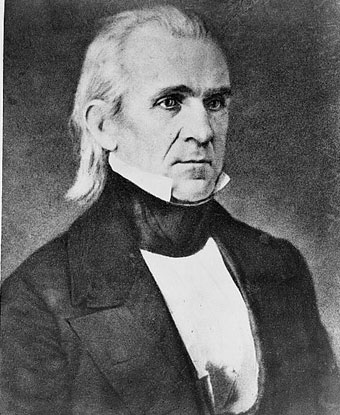Last updated: June 21, 2019
Person
James Knox Polk

Brady-Handy Collection, Library of Congress
Early Life
James Knox Polk was born in Mecklenburg County, North Carolina but moved with his family to Tennessee in 1806. Polk attended the University of North Carolina graduating with honors. James Polk studied law and was admitted to the Tennessee bar in 1820. Polk had larger designs for himself.He sought and won election to the Tennessee legislature in 1823. While serving in the legislature, Polk became a firm supporter of Andrew Jackson. A year later, Polk would marry Sarah Childress. The couple would never have children. Polk’s political ambitions would take him to the Tennessee Governor’s Office in 1839.
Presidential Election of 1844
In 1844 James Polk found himself the favorite for the Democratic Vice-Presidential nomination. But instead he turned his eyes towards the Presidency. Basing his platform on U.S. expansionism, Polk defeated Henry Clay, the Whig Presidential nominee, and become the first “dark horse” President.During his campaign, Polk stated Texas should be re-annexed and Oregon re-occupied. Polk was able to settle the Oregon issue with Great Britain diplomatically. The result of which was an agreement on a boundary at the 49th parallel. Texas would prove to be a different matter.
In 1845, the United States annexed Texas making it the 28th state. Mexico viewed this as an act of aggression because it had never recognized Texas independence. In addition, Mexico maintained the southern boundary of Texas was the Nueces River. Texas countered that claimed by maintaining the Rio Grande to be its southern boundary.
Further complicating relations between the U.S. and Mexico was Polk's desire to acquire the California and the New Mexico territories from Mexico. To this end Polk sent John Slidell to Mexico, offering $20 million in exchange for this vast territory. Slidell did not receive a warm welcome when he arrived. No one with the authority to enter such negotiations would comprise their political career by doing so.
War with Mexico
With expansion progress stalling, Polk sent General Zachary Taylor to the disputed area between Texas and Mexico. Taylor and his Army of Occupation arrived on the banks of the Rio Grande in March 1846. The Mexican government mobilized a force to dislodge General Taylor and his troops. The two armies clashed on May 8th at Palo Alto and May 9th at Resaca de la Palma starting the U.S.-Mexican War. The Mexican Army was unsuccessful and Taylor continued his campaign into northern Mexico earning victories at Monterrey and Buena Vista.Still unable to get Mexico to negotiate, President Polk sent General Winfield Scott on a campaign to capture the Mexican capital. General Scott's army landed at Veracruz capturing the port city and then on into the Valley of Mexico. The general took Mexico City in September 1847 after a spirited defense of the capital by General Santa Ana's Army. The war was over.
Sea to Shining Sea
The Treaty of Guadalupe Hidalgo, signed in February 1848, settled the border question between Texas and Mexico and outlined the exchange of California and New Mexico for $15 million. President Polk had finally achieved what he had set out to do, extend the boundaries of the U.S. from sea to shining sea. The U.S. had acquitted about 1 million square miles as a result of the war. The addition of territory came with a price. The addition of this new land stirred debate between the North and the South over the expansion of slavery—a debate that erupted 13 years later in the Civil War.Post-Presidency
President James K. Polk maintained his pledge to serve only one term. His time in the Oval Office took its toll on his health. He and Sarah Polk embarked on a tour of the South in early March 1849. The plan was to end the tour in Nashville where Polk had purchased a home, later known as Polk Place. James Polk became ill along the way and feared he had contracted cholera.The couple eventually made it to Nashville in early April. All was well until June when Polk fell ill again, more than likely with cholera. He held on for some days, eventually dying on June 15, 1849. Sarah Polk would live at Polk Place for another 42 years.
